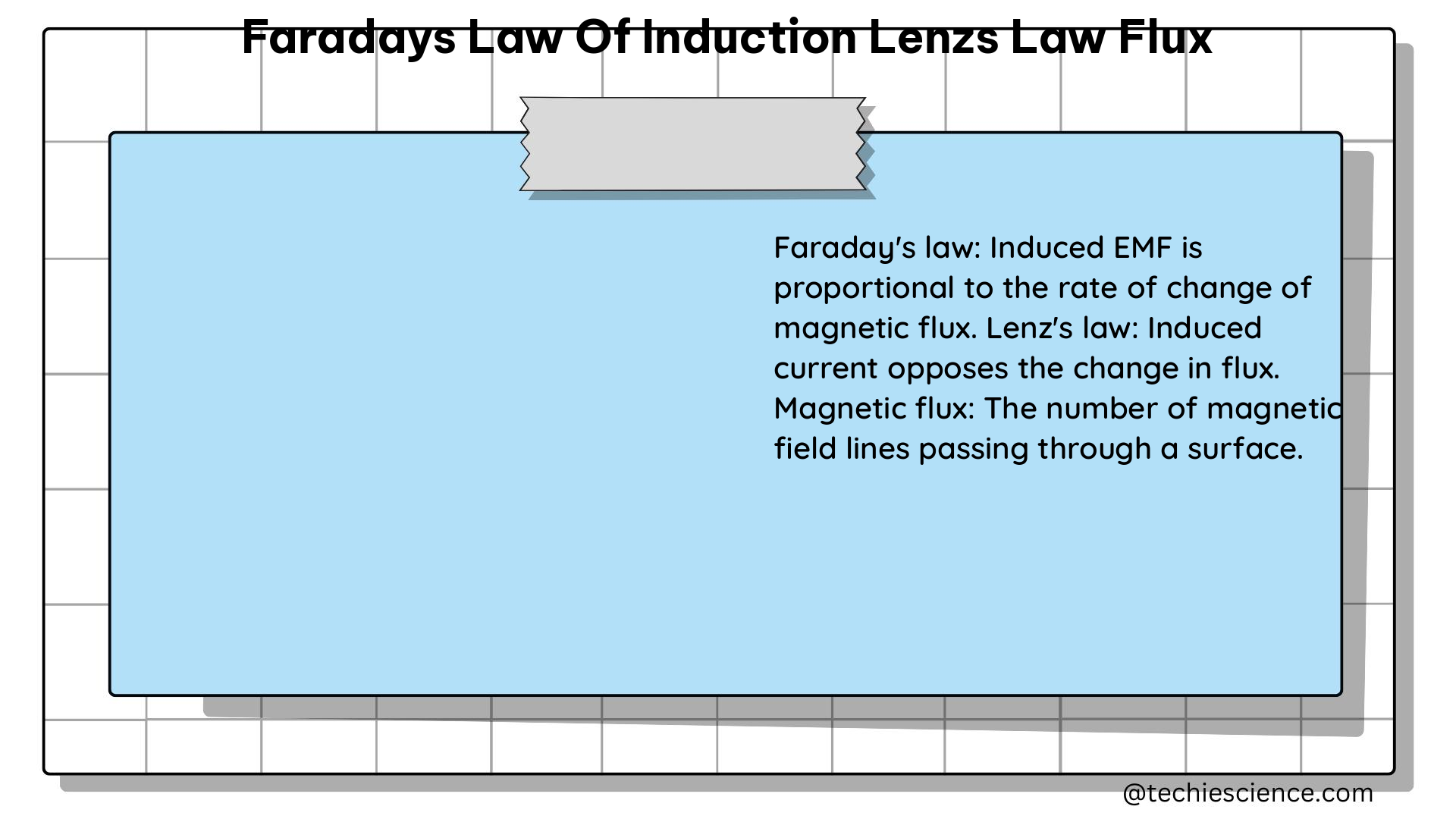Faraday’s Law of Induction and Lenz’s Law are fundamental principles in electromagnetism that describe the relationship between changing magnetic fields and the induced electromotive forces (EMFs) they create. These laws are essential for understanding the behavior of various electromagnetic devices, from transformers and generators to induction motors and wireless charging systems. In this comprehensive guide, we will delve into the mathematical formulations, key concepts, practical applications, and numerical examples related to these important laws.
Faraday’s Law of Induction
Faraday’s Law of Induction states that the induced EMF in a circuit is proportional to the rate of change of the magnetic flux through the circuit. The mathematical expression for Faraday’s Law is:
[
\text{emf} = -N \frac{\Delta \Phi}{\Delta t}
]
Where:
– emf: Electromotive force (volts, V)
– N: Number of turns in the coil
– ΔΦ: Change in magnetic flux (weber, Wb)
– Δt: Time over which the flux changes (seconds, s)
The negative sign in the equation indicates that the induced EMF opposes the change in magnetic flux, as described by Lenz’s Law.
Magnetic Flux
Magnetic flux, denoted as Φ, is a measure of the total magnetic field passing through a given surface or area. The formula for magnetic flux is:
[
\Phi = B \cdot A \cdot \cos \theta
]
Where:
– Φ: Magnetic flux (weber, Wb)
– B: Magnetic field strength (tesla, T)
– A: Area of the coil (square meters, m²)
– θ: Angle between the magnetic field and the coil normal (degrees)
The magnetic flux is directly proportional to the magnetic field strength, the area of the coil, and the cosine of the angle between the magnetic field and the coil normal.
Lenz’s Law

Lenz’s Law states that the direction of the induced current in a circuit is such that it opposes the change in the magnetic flux that caused it. In other words, the induced current will create a magnetic field that opposes the original change in the magnetic field.
To determine the direction of the induced current, you can use the right-hand rule:
1. Point your thumb in the direction of the magnetic field.
2. Curl your fingers around the coil or circuit.
3. The direction your fingers curl is the direction of the induced current.
This rule helps you visualize the direction of the induced current and ensures that it opposes the change in the magnetic flux, as described by Lenz’s Law.
Examples and Applications
Induction Cooker
- Magnetic Field Strength: Typically around 100 mT (millitesla)
- Frequency: 27 kHz (kilohertz)
- Induced EMF: High values due to the high rate of change of the magnetic field
Induction cookers use the principles of electromagnetic induction to heat cookware. The rapidly changing magnetic field induces a high EMF in the metal cookware, which in turn generates heat through eddy currents.
Transformer
- Mutual Inductance: The ability of two coils to induce EMFs in each other
- Efficiency: Transformers can achieve high efficiency (up to 99%) due to the principles of electromagnetic induction
Transformers rely on the mutual inductance between two coils to step up or step down the voltage in an electrical system. The changing magnetic field in the primary coil induces a corresponding EMF in the secondary coil, allowing for efficient power transformation.
Electric Generator
- EMF: Varies sinusoidally with time
- Angular Velocity: The coil is rotated at a constant angular velocity to produce the EMF
Electric generators convert mechanical energy into electrical energy by using the principles of electromagnetic induction. As a coil is rotated in a magnetic field, the changing magnetic flux induces an EMF that varies sinusoidally with time.
Numerical Problems
Example 1
- Change in Flux: 2 Wb to 0.2 Wb in 0.5 seconds
- Induced EMF: Calculate the induced EMF using Faraday’s Law
Solution:
[
\Delta \Phi = 0.2 – 2 = -1.8 \text{ Wb}
]
[
\text{emf} = -N \frac{\Delta \Phi}{\Delta t} = -N \frac{-1.8}{0.5} = 3.6 N \text{ V}
]
Example 2
- Coil Area: 0.1 m²
- Magnetic Field Strength: 0.5 T
- Angle: 30°
- Number of Turns: 100
- Time: 0.2 seconds
- Change in Flux: Calculate the change in flux and the induced EMF
Solution:
[
\Phi = B \cdot A \cdot \cos \theta = 0.5 \cdot 0.1 \cdot \cos 30° = 0.043 \text{ Wb}
]
[
\Delta \Phi = 0.043 \text{ Wb}
]
[
\text{emf} = -N \frac{\Delta \Phi}{\Delta t} = -100 \frac{0.043}{0.2} = -21.5 \text{ V}
]
References
- Lumen Learning. (n.d.). Faraday’s Law of Induction: Lenz’s Law. Retrieved from https://courses.lumenlearning.com/suny-physics/chapter/23-2-faradays-law-of-induction-lenzs-law/
- Boundless Physics. (n.d.). Magnetic Flux, Induction, and Faraday’s Law. Retrieved from https://www.collegesidekick.com/study-guides/boundless-physics/magnetic-flux-induction-and-faradays-law
- ScienceDirect. (n.d.). Faraday’s Law. Retrieved from https://www.sciencedirect.com/topics/physics-and-astronomy/faradays-law
- GeeksforGeeks. (2022). Faraday’s Law of Electromagnetic Induction: Experiment & Formula. Retrieved from https://www.geeksforgeeks.org/faradays-law/
- Science in School. (2021). Faraday’s law of induction: from classroom to kitchen. Retrieved from https://www.scienceinschool.org/article/2021/faradays-law-induction-classroom-kitchen/
Hi, I am Amrit Shaw. I have done Master in Electronics.
I always like to explore new inventions in the field of Electronics.
I personally believe that learning is more enthusiastic when learnt with creativity.
Apart from this, I like to strum Guitar and travel.